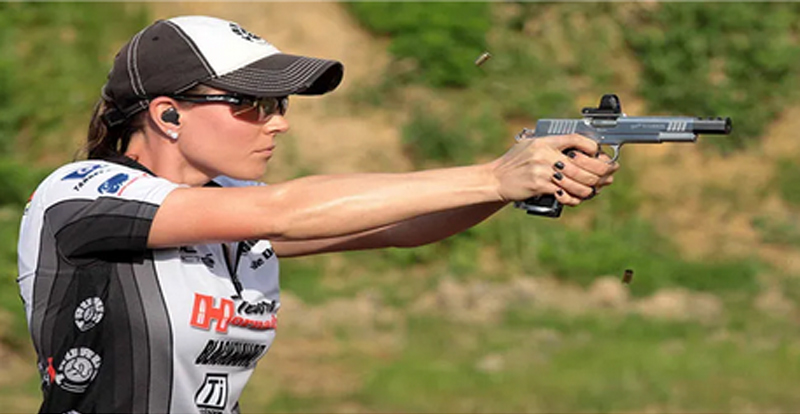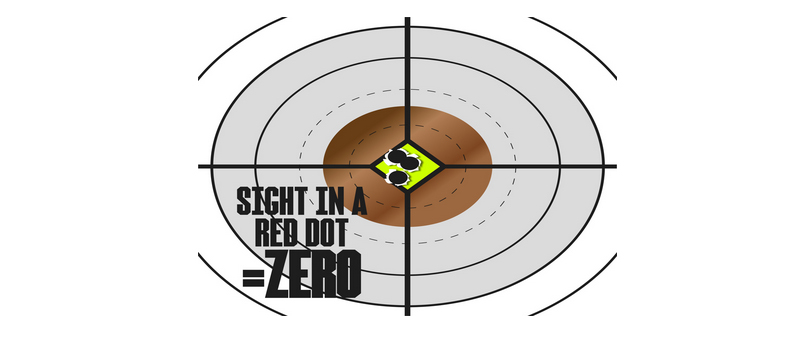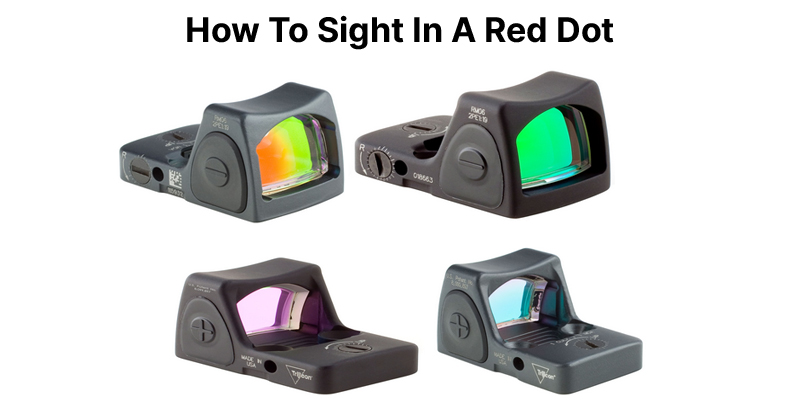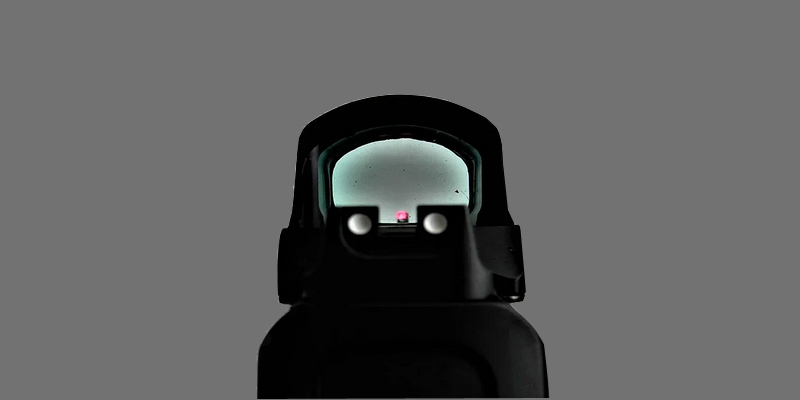How To Sight In A Red Dot.
Red dot sights are becoming increasingly famous among shooters of all levels. They offer several benefits over traditional iron sights, including faster target acquisition and better accuracy. However, to get the most out of a red dot sight, it's important to see it properly. This blog post will tell you How to sight in a red dot sight.
What is a red dot sight?
A red dot sight stands as a non-magnifying reflector sight, presenting users with an illuminated red dot that serves as a precise point of aim. Typically, this sight employs a conventional design featuring a red light-emitting diode (LED) strategically positioned within collimating optics. The outcome is a reticle in the form of an illuminated dot seamlessly aligned with the firearm to which the sight is affixed, ensuring consistent alignment irrespective of the shooter's eye position.
Red dot sights are a great choice for a variety of shooting applications, including:
- Home Defense
- Tactical shooting
- Hunting
What You Need
Here are some explanations for the items you need to sight in a red dot sight:
- Red dot sight: This is the device you will use to sight in your firearm. Red dot sights are easy to use and great for beginners and experienced shooters.
- Rifle or pistol: You can sight a red dot on a rifle or pistol. However, choosing the right type of firearm for your needs is important. A pistol is a good option if you use your red dot sight for self-defense. A rifle is better if you use your red dot sight for hunting.
- Ammunition: You will need ammunition to sight in your red dot sight. It is important to use the same type of ammunition that you will be using for self-defense or hunting. This will help to ensure that your red dot sight is sighted in correctly for the type of ammunition you will be using.
- Target: You will need a target to sight in your red dot sight. A target should be large enough to see your shots but not so large that it is difficult to hit. A good target size for red dot sight is about 12 inches in diameter.
- Shooting range: You will need to sight in your red dot sight at a shooting range. This is important for safety, as it will allow you to shoot your firearm in a controlled environment.
Why should you sight in your red dot sight?
To ensure accuracy: When a red dot sight is not sighted in correctly, the bullet's point of impact will not be the same as the point of aim. This can lead to missed shots, which can be dangerous in self-defense or other critical shooting scenarios.
To improve target acquisition: A properly sighted red dot sight will allow you to acquire targets more quickly and accurately. This is because you will not have to worry about lining up two separate sights as with iron sights.
To get the most out of your red dot sight: A red dot sight is a valuable tool, but it is only effective if it is sighted in correctly. By taking the time to see in your red dot sight, you will get the most out of it and improve your shooting accuracy.
Steps to Sight in a Red Dot Sight
 Image Credit: https://blog.cheaperthandirt. com
Image Credit: https://blog.cheaperthandirt. com
- Choose the right target. The target should be the same distance from you as you will be shooting at in real life. For example, if you will be shooting at a target 100 yards away, you should choose a target 100 yards away.
- Mount your red dot sight. Ensure the red dot sight is mounted securely on your rifle or pistol. The red dot sight should be level and in the correct position. You may need to use a level to ensure the red dot sight is level.
- Use a bore sighter. A bore sighter is a tool that can help you get your red dot sight close to zero before you start shooting. To use a bore sighter, insert it into the barrel of your rifle or pistol. Line up the bore sighter with the target. Adjust the red dot sight until the laser from the bore sighter hits the target. Once the laser hits the target, you can start shooting to confirm your zero.
- Shoot 3-5 rounds at your target. Aim at the center of the target and shoot 3-5 rounds. Adjust the red dot sight if your shots are not hitting the target.
- Make adjustments to your red dot sight. The elevation adjustment on your red dot sight will move the point of impact up or down. The windage adjustment on your red dot sight will move the point of impact left or right. To adjust, turn the adjustment knob until the point of impact is where you want it to be. Be sure to make small adjustments and shoot again to confirm the point of impact before making further adjustments.
Choose a sighting distance.
The best sighting distance for a red dot sight depends on the shooting you will be doing. For most general-purpose shooting, a sighting distance of 25 yards is a good starting point. This will allow you to get a good zero and be accurate at most distances you will likely encounter.
 Image Credit: https://tacticon. com
Image Credit: https://tacticon. com
If you do more precision shooting, you may want to choose a longer sighting distance, such as 50 or 100 yards. This will give you more precision at longer ranges.
When choosing a sighting distance, it is also important to consider the type of red dot sight you have. Some sights are designed for close-range shooting, while others are designed for longer-range shooting. Make sure to choose a sighting distance appropriate for the type of red dot sight you have.
Additional factors to consider when choosing a sighting distance:
- The type of firearm you are using. Some firearms are more accurate at longer ranges than others. Make sure to choose a sighting distance that is appropriate for the firearm you are using.
- Your skill level. If you are a beginner shooter, start with a shorter sighting distance. This will give you more room for error and make it easier to get a good zero.
- If you are shooting in windy conditions, you may want to choose a shorter sighting distance.
Ultimately, the best way to choose a sighting distance is to experiment and see what works best for you. Start with a 25-yard sighting distance and then adjust it as needed. Once you have found a sighting distance you are comfortable with, you can confirm your zero at that distance.
Prepare your firearm
Here are the steps on how to prepare your firearm for sighting in a red dot sight:
- Make sure your firearm is safe to handle. This means checking the chamber to ensure no ammunition is present and removing the magazine. You should also make sure the firearm is not cocked.
- Attach a red dot sight to your firearm according to the manufacturer's instructions. Be sure to securely tighten the screws on the red dot sight so it does not move during firing.
- If your red dot sight has windage and elevation adjustments, make sure they are set to zero. This means that the sight is aligned perfectly with the barrel of your firearm. You can usually zero your red dot sight by following the instructions in the manufacturer's manual.
Here are some additional safety tips to keep in mind when preparing your firearm for sighting in a red dot sight:
- Keep your finger off the trigger until you are ready to fire.
- Be aware of your surroundings and ensure people or animals are in the line of fire.
- Check the chamber. Make sure the chamber is empty.
- Load your firearm with ammunition. Only load the magazine with the number of rounds you plan to shoot.
- Check the safety. Make sure the safety is on.
Find a shooting range
Find a shooting range to shoot at your chosen sighting distance. Most shooting ranges have a variety of distances available, but not all of them will allow you to shoot at the exact space you need. Be sure to check with the range before you go to ensure they have the right distance for you.
 Image Credit: https://www.leupold. com
Image Credit: https://www.leupold. com
Set up your target at the desired distance. Once you have found a shooting range that allows you to shoot at the right length, you must set your target. The target should be large enough to see your shots but not so large that it is difficult to hit. A good target size for red dot sight is about 12 inches in diameter.
Make sure the target is stable. The target should be sturdy so it does not move when you shoot at it. You can use sandbags or other objects to stabilize the target.
Confirm your zero
Once you have sighted your red dot sight at the desired distance, you need to confirm your zero. This means shooting at the target again and ensuring your shots still hit the same spot.
 Image Credit: https://tacticon. com
Image Credit: https://tacticon. com
To confirm your zero, follow these steps
- Use good-quality ammo. Using good-quality ammo will help you get a more accurate zero. Shoot from a rest. Shooting from rest will help you stabilize your rifle or pistol and make it easier to get a good zero.
- Make small adjustments. When making adjustments to your red dot sight, make small adjustments and shoot again to confirm the point of impact before making further adjustments.
- Shoot 3-5 rounds at the center of the target.
- Be patient. Getting your red dot sight perfectly zeroed may take a few tries. Be patient and keep practicing.
- Your zero is confirmed if your shots are all hitting the same spot.
- If your shots hit a different spot, adjust your red dot sight until they are.
- Repeat steps 2-3 until your zero is confirmed.
Conclusion
In conclusion, sighting a red dot sight is refreshingly straightforward and can be accomplished in just a few uncomplicated steps. By adhering to the comprehensive guidance provided within this blog post, you're empowered to guarantee the accurate alignment of your red dot sight. This precision translates directly to your ability to consistently and precisely hit your intended targets.
- Be patient. It may take a few tries to get your red dot sighted perfectly. Be patient and keep practicing.
- Have fun! Sighting in a red dot sight can be a fun and rewarding experience. Enjoy the process, and take your time to do it right.
- Reiterate the importance of safety. Sighting in a red dot sight should always be done in a safe environment, such as a shooting range. Be sure to follow all the safety precautions outlined in this blog post, and always wear eye and ear protection when shooting.


 Image Credit: https://blog.cheaperthandirt. com
Image Credit: https://blog.cheaperthandirt. com
 Image Credit: https://tacticon. com
Image Credit: https://tacticon. com
 Image Credit: https://www.leupold. com
Image Credit: https://www.leupold. com
 Image Credit: https://tacticon. com
Image Credit: https://tacticon. com